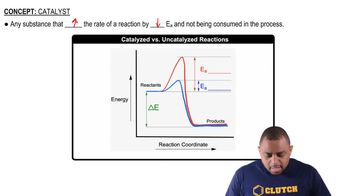Here are the essential concepts you must grasp in order to answer the question correctly.
Le Chatelier's Principle
Le Chatelier's Principle states that if a dynamic equilibrium is disturbed by changing the conditions, the position of equilibrium shifts to counteract the change. This principle helps predict how the concentration of reactants and products will change in response to alterations such as volume, temperature, or concentration.
Recommended video:
Equilibrium Constant (Kc)
The equilibrium constant (Kc) is a numerical value that expresses the ratio of the concentrations of products to reactants at equilibrium, each raised to the power of their coefficients in the balanced equation. Changes in temperature can affect the value of Kc, while changes in concentration or volume do not alter Kc but can shift the position of equilibrium.
Recommended video:
Equilibrium Constant Expressions
Catalysts and Inert Gases
Catalysts are substances that increase the rate of a reaction without being consumed, and they do not affect the position of equilibrium or the value of Kc. Similarly, the addition of an inert gas at constant temperature and volume does not change the concentrations of the reactants or products, thus having no effect on the equilibrium composition or Kc.
Recommended video:
Catalyzed vs. Uncatalyzed Reactions
 Verified step by step guidance
Verified step by step guidance

